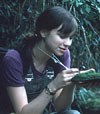Centre for Plant Biodiversity Research
 Danielle
Medek
Danielle
Medek
CPBR Summer Vacation Scholarship
Supervisor: Dr Christine Cargill
Asterella drummondii is a complex thallose liverwort, which occurs throughout Australia. The existence of different morphologies within this species group raises the question: Is Asterella drummondii really one species? Close study of thallus morphology and spore characteristics in herbarium specimens has provided evidence for the separation of Asterella drummondii populations into two distinct groups.
Complex thallose liverworts have a thallus with a photosynthetic and a storage layer. The reproductive structure is a carpocephalum housing a reduced sporophyte. Spores are discharged en masse from a capsule, aided by specialized hygroscopic spring-like cells called elaters. Asterella, a liverwort of this sort, is typified by the presence of a basket-like pseudoperianth surrounding the spore capsule. The species complex, Asterella drummondii, occurs over much of Australia in moist or sheltered places. Like many other cryptogams, it is able to survive dehydration and in some Asterella populations this is achieved by curling its margins over the dorsal surface of the thallus during dry periods. Pigmentation in the ventral scales and undersurface of the plant may also protect the thallus from photodegradation. Not all populations of Asterella drummondii exhibit pigmentation, nor do all populations have curled thalli. Between populations there is considerable variation in spore colour, size and ornamentation as well as in elater width. The aim of this project was to establish a suite of informative characters from both the gametophyte and sporophyte in a number of collections from New South Wales populations, and therefore to determine if there is more than one species within the Asterella drummondii complex.
Herbarium collections of Asterella drummondii from NSW and the ACT were examined for those populations, which bore spores. Those that had spores (26 populations) were analyzed. Spores were measured through the optical light microscope and the scanning electron microscope. Characters observed were spore colour, diameter (proximal to distal and across the equator), number of lamellae across the diameter of the proximal and distal faces, wing width, trilete mark width and lamellar and surface characteristics. Elater width and length, as well as spiral number was also measured. Thalli of similar age were boiled to rehydrate the plants, and were observed through a dissecting microscope. Thallus width, depth and colour were recorded as well as pore ring numbers, ventral scale shape and colour and various carpocephalum characters. A matrix of qualitative and quantitative characters was created. Frequency histograms were constructed for quantitative data to determine whether characters were continuous or discontinuous. Both univariate and multivariate analyses were carried out on the data including single factor analysis of variance (ANOVAs) and cluster and ordination analyses.
Frequency histograms showed unimodal distributions among all characters measured except for elater width, which was clearly bimodal. The results of single factor ANOVAs for each of the variables showed that morphological variation was attributable to variation among rather than within populations. The results of both the cluster analysis and the principal coordinates analysis consistently separated a group of four populations from the remainder. These were: HSMcK 11669, HS 61476, JAC 3229 and HS 4979.
Spore and gametophytic features support the separation of the populations studied into two groups. The four populations that separated out together shared morphological traits such as smaller spore diameter; lacy patterned lamellae on the spore surface and red spore colour. They had broad thalli that lacked ventral pigmentation, thallus margin pigmentation and the habit of curling up when dehydrated. Other populations tended to have narrow thalli with pigmented margins that curled up, as well as large, yellow, smooth spores.
The value of characters to separate species in these genera has been questioned. Differences such as spore colour and thallus pigmentation may be environmentally induced rather than of genetic origin. It has been concluded that many of these characters are of genetic origin, however, as thalli collected from similar habitats and from similar geographic regions, such as Black Mountain show morphological differences. Growing some of the different thallus types under the same environmental conditions would indicate how light and water levels affect pigmentation and thallus size. Molecular data could also be utilised to support division of the species complex into the two groups.
This study has revealed which characters are reliable ones to measure. Other characters worth measuring, such as whether ventral scales project over the thallus margin, have also been identified.
The study has yielded encouraging results, concluding that the Asterella drummondii complex of the NSW and ACT region contains more than one species.